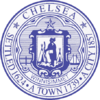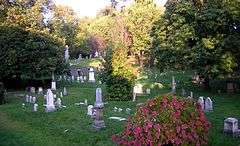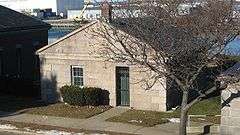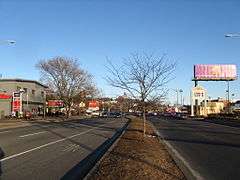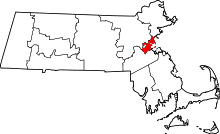Chelsea, Massachusetts
| Chelsea, Massachusetts | ||
|---|---|---|
| City | ||
|
The Tobin Bridge, linking Chelsea and Boston | ||
| ||
 Location in Suffolk County and the state of Massachusetts | ||
 Chelsea, Massachusetts Location in the United States | ||
| Coordinates: 42°23′30″N 71°02′00″W / 42.39167°N 71.03333°WCoordinates: 42°23′30″N 71°02′00″W / 42.39167°N 71.03333°W | ||
| Country | United States | |
| State | Massachusetts | |
| County | Suffolk | |
| Settled | 1624 | |
| Incorporated | 1739 | |
| Government | ||
| • Type | Council-manager government | |
| • City Manager | Thomas G. Ambrosino | |
| • Deputy City Manager | Ned Keefe | |
| Area | ||
| • Total | 2.5 sq mi (6.4 km2) | |
| • Land | 2.2 sq mi (5.7 km2) | |
| • Water | 0.2 sq mi (0.6 km2) | |
| Elevation | 10 ft (3 m) | |
| Population (2014) | ||
| • Total | 38,861 | |
| • Density | 17,664.1/sq mi (6,820.1/km2) | |
| Time zone | Eastern (UTC-5) | |
| • Summer (DST) | Eastern (UTC-4) | |
| Zip code | 02150 | |
| Area code(s) | 617 / 857 | |
| FIPS code | 25-13205 | |
| GNIS feature ID | 0612723 | |
| Website | http://www.ci.chelsea.ma.us | |
Chelsea is a city in Suffolk County, Massachusetts, United States, directly across the Mystic River from the city of Boston. As of 2013, Chelsea had an estimated population of 36,828.[1] It is also the second most densely populated city in Massachusetts behind Somerville. With a total area of just 2.5 square miles, Chelsea is the smallest city in Massachusetts in terms of total area.[2]
Chelsea is a diverse, working-class community that contains a high level of industrial activity. It is one of only 4 Massachusetts cities in which either the majority or a plurality of the population identifies as Hispanic or Latino, alongside Springfield, Lawrence and Holyoke. After flirting with bankruptcy in the 1990s, the once-struggling industrial city has reversed a prolonged decline and in recent years has enjoyed sustained economic growth. Thanks to its relative affordability and close proximity to Boston, Chelsea has added more than 1,200 homes since 2005, mostly loft-style apartments and condominiums suitable for small families or young professionals. There has also been significant office, retail and restaurant development throughout the city.[3]
History

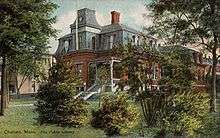
The area of Chelsea was first called Winnisimmet (meaning "good spring nearby") by the Massachusett tribe, which once lived there. It was settled in 1624 by Samuel Maverick, whose palisaded trading post is considered the first permanent settlement by Boston Harbor. In 1635, Maverick sold all of Winnisimmet, except for his house and farm, to Richard Bellingham. The community remained part of Boston until it was set off and incorporated in 1739, when it was named after Chelsea, a neighborhood in London, England.
In 1775, the Battle of Chelsea Creek was fought in the area, the second battle of the Revolution, at which American forces made one of their first captures of a British ship. Part of George Washington's army was stationed in Chelsea during the Siege of Boston.
On February 22, 1841, part of Chelsea was annexed by Saugus, Massachusetts. On March 19, 1846, North Chelsea, which consists of present-day Revere and Winthrop was established as a separate town.[4] Reincorporated as a city in 1857, Chelsea developed as an industrial center and by mid-century had become a powerhouse in wooden sailing ship construction. As the century wore on, steam power began to overtake the age of the sail and industry in the town began to shift toward manufacturing. Factories making rubber and elastic goods, boots and shoes, stoves, and adhesives began to appear along the banks of Boston Harbor. It became home to the Chelsea Naval Hospital designed by Alexander Parris and home for soldiers.[5]
According to local historical records, Nathan Morse, the first Jewish resident of Chelsea, arrived in 1864, and by 1890 there were only 82 Jews living in the city. However, Chelsea was a major destination for the "great wave" of Russian and Eastern European immigrants, especially Russian Jews, who came to the United States after 1890. By 1910 the number of Jews had grown to 11,225, nearly one third of the entire population of the city. In the 1930s there were about 20,000 Jewish residents in Chelsea out of a total population of almost 46,000. Given the area of the city, Chelsea may well have had the most Jews per square mile of any city outside of New York City.[6]

On April 12, 1908, nearly half the city was destroyed in the first of two great fires that would devastate Chelsea in the 20th century. The fire left 18,000 people, 56 percent of the population, homeless. Despite the magnitude of the destruction, it would only take the city about two and a half years to rebuild and five years to surpass the extent of 1908's infrastructure. The city was also laid out differently after the fire, with wider streets and more access for emergency vehicles. Many of the city’s residents left and never returned, which opened the door for many immigrants living in Boston to “move up” to Chelsea. To immigrants living in crowded tenements in Boston’s West End, East and South Ends, Chelsea was the next stop on their path of economic upward mobility.[7]
By 1919 Chelsea’s population had reached the record level of 52,662, with foreign-born residents comprising 46 percent of the population. Fully transitioned from a suburb to an industrial city, the waterfront flourished, with shipbuilding, lumberyards, metalworks and paint companies lined Marginal Street.[5]
During the 1930s the first exodus of Jews from Chelsea to the suburbs began. As the community prospered and grew, many wanted to seek new opportunities in the more affluent communities of Newton and Brookline. By the 1950s the Jewish population had decreased to about 8,000 and more people began to establish roots in the seaside towns of Swampscott and Marblehead, Massachusetts.[8]
After World War II, Chelsea began a long, slow decline; between 1940 and 1980, the population declined by 38 percent. Chelsea, however, lost more population than other urban areas after the 1950s because of the elevated expressway built to connect the North Shore to Boston, via the Mystic River Bridge (later renamed for Boston Mayor Maurice J. Tobin). The highway planners failed to foresee that the new Route 1 North Expressway would damage the city far more than the 1908 fire. Hundreds of homes were lost to make way for the expressway as it cut the city in half. The resulting out-migration took with it many of the small, local businesses, much of the capital and, seemingly, the soul of the city. Historic homes were abandoned, along with the industrial buildings, brownfields, salt piles and gas storage tanks dotting the cityscape.
In 1973, disaster struck again when the Second Great Chelsea Fire burned 18 city blocks, leaving nearly a fifth of the city in ashes. Both fires originated in Chelsea’s “rag shop district,” cluttered streets filled with junk shops hawking scraps, metal, and combustible items. Wood-frame buildings and three- to six-family houses were built tightly together, and quickly caught fire.[9]
A major shift took place in the early 1970s as Chelsea became a center for Latino immigration. Racial conflict and tension became a regular part of life in Chelsea. Although the Hispanic population continued to grow, the city did not hire its first Spanish-speaking police officer until 1992. By the early 1990s, Chelsea was both the poorest and most dangerous city in Massachusetts.
By 1990, Chelsea had collapsed economically and socially. Crime was rampant, not least among the police and local government officials. The population drain made way for more immigrants, but depleted the city’s tax base. The cost of running the city and maintaining its infrastructure did not decrease correspondingly so, in 1991, the city suffered fiscal collapse. The Commonwealth of Massachusetts enacted special legislation to place Chelsea into receivership. For the first time since the Great Depression, a Massachusetts city surrendered home rule and allowed a state-appointed receiver to control all aspects of city government. City Hall was eviscerated, the police and fire departments reorganized, management of the public schools given to Boston University, and indictments handed down. Mayor John “Butchie” Brennan and two former mayors were found guilty of federal crimes.
Governor William Weld named James Carlin as the first receiver followed by Lewis "Harry" Spence. This was the first time since the Great Depression that a major United States municipality had such an action taken against it. Events preceding the action included failed financial intervention by the state, a political stalemate over the city's budget, deepening economic decline and a spiraling fiscal crisis. Fortunately, Chelsea had no long-term debt publicly held; thus, a solution to its problems could be explored in isolation of creditors.[10]
By the summer of 1995, when the state returned City Hall to the people of Chelsea, a new government had been born, brought to live by a panel of citizens charged with drafting a new city charter. The new charter eliminated the position of mayor, converting management of the city from a strong mayor to a council–manager government system, where a strong city manager is selected by City Council members. As such, municipal government focused on improving the quality of services provided to residents and businesses, while establishing financial policies that have significantly improved the city's financial condition. With their leaders more accountable and efficient, Chelsea reversed its long decline and entered a period of population growth and economic development.
In 1998, the City Council's focused efforts earned Chelsea the distinction of being named one of 10 All-America City Award winners by the National Civic League in recognition of its grass-roots approach to solving problems. Since earning that honor, Chelsea has claimed other victories. The city weathered a recession in the early 2000s and emerged with its finances intact, prompting Chelsea's bond rating to improve.
Chelsea's skyline has been transformed by the construction of the Wyndham Chelsea, built on a lot where junk cars once sat abandoned in the wake of the fire of 1973. Opened in 2001, the hotel chain was the first company to make a substantial investment in Chelsea after receivership. The city’s two main shopping centers, the Mystic Mall and Chelsea Commons, have recently undergone major renovations as well.[11]
On July 28, 2014, a tornado touched down in northern Chelsea and made its way to neighboring Revere. While there was relatively little damage in Chelsea, it caused major damage in Revere.[12]
Geography

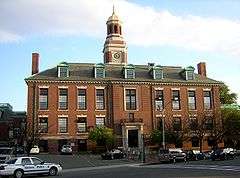
Located on a small peninsula in Boston Harbor covering a mere 2.21 square miles (6 km2), Chelsea is the smallest city by area in Massachusetts. Chelsea is bordered on three sides by water, giving the city a unique character. The Mystic River borders Chelsea on the southwest, the Chelsea Creek and Mill Creek and the Island End River on the west.
The topography of Chelsea consists primarily of coastal lowlands, punctuated by four drumlins formed during the last Ice Age. These drumlins are located in the southwest (Admirals Hill), southeast (Mount Bellingham), northeast (Powderhorn Hill) and northwest (Mount Washington). A smaller drumlin (Mill Hill) is located on the east side of Chelsea, adjacent to Mill Creek. This sloped and hilly landscape helps to divide the city into discernible neighborhoods, each with its own character, thereby giving the city a manageable sense of scale and orientation.
Neighborhoods and districts
Despite its small size, there are several distinct neighborhoods in Chelsea:
Admirals Hill - Admirals Hill sits atop a point of land between the Mystic River and Island End River. Containing the Naval Hospital Historic District, the area is mostly residential development enjoying expansive views. On the south slope of the hill is the site of the historic Chelsea Naval Hospital, with several brick and granite structures that have been converted to other uses. Between the Naval Hospital and the shoreline is the Mary O'Malley Park, the largest public park in Chelsea.
Addison-Orange Adjacent to the north side of downtown, the Addison-Orange neighborhood is residential, flat and densely populated. Washington Avenue runs through this neighborhood.
Bellingham Square - This historic district became the center of commerce and government after the 1908 fire. The cohesiveness of design is the result of community planning after the Great Fire of 1908. The district includes City Hall, modeled after Old Independence Hall in Philadelphia, the Public Library and Bunker Hill Community College's Chelsea campus. "Google Maps- Kayem Park is in this neighborhood."
Box District - Just over a block from City Hall, this once blighted neighborhood gets its name from various box manufacturing companies that operated in the area as early as 1903, when the Russell Box Company began operations at the foot of Gerrish Avenue. Abandoned in the 1960s, the area fell into disrepair until it was rezoned for residential use in the 2000s. It is now the fastest growing part of Chelsea and has enjoyed a building boom since 2005, with town homes and multifamily housing complexes proliferating in the area.[13] The Chelsea Family Dental is also located here, and the Kayem Food Headquarters are off Marginal Street.
Carter Park- Wyndham Area - The neighborhood around Carter Park is a small enclave of mostly single-family Queen Anne style homes surrounded by heavy commercial and highly trafficked areas. Route 1 looms above the southeastern edge of this tree-lined neighborhood, and Revere Beach Parkway winds along the northern edge. The Chelsea High School is in this area, as well as Market Basket, the Dockside, Home Goods, T.J. maxx and Floramo's. The historic Chelsea Clock is also in the area.
Chelsea Square - This historic district located in the downtown area contains the finest and most intact grouping of mid 19th and early 20th century commercial architecture in the city. Area includes a waterfront district (South Broadway neighborhood) with brick row houses dating to the mid to late 19th century. Third Street is also in the area, and becomes the industrial Everett Avenue. The Chelsea Police Department is located here.
Chelsea Commons - Formerly known as Parkway Plaza, Chelsea Commons sits on a low flat area near the end of Mill Creek. The plaza consists of big-box retail, fast-food restaurants, and a large apartment building. It is bordered by a strip of wetlands on both sides. The new Chelsea Commons Park was just completed adjacent to this site. Webster Avenue is in this area.
Mill Hill - This largely residential area consists mostly of two- and three-story wood frame detached buildings. Covering the smallest of the city's drumlins, the Mill Hill neighborhood sits on a small neck of land bounded by Chelsea Creek and Mill Creek. This neighborhood is on the Revere line. Eastern Avenue goes through his neighborhood.
Prattville - is the northwestern section of the city. It also borders Revere, and Everett to the west. Pizza Lovers, The Newbridge Cafe and Orange Leaf Frozen Yogurt are located in this area. Garfield and Washington Avenues are in Prattville. Voke and Washington parks are in Prattville. Route 1 is on the east side of Prattville, and Route 16 is on the south side.
Soldiers Home - The Soldiers Home neighborhood covers the steep slopes and the peak of Powderhorn Hill. This residential area contains some examples of Queen Anne style architecture. Soldiers Home is one of the least dense neighborhoods in the city. At the peak sits the Soldiers Home, a large structure that dominates much of this area. However, there are some smaller associated brick structures in the area as well.
Waterfront District - For the first time, Chelsea is breaking through the heavy industry piled up along the Chelsea Creek, and reconnecting with its waterfront. Established to promote water-oriented industrial uses at Forbes Industrial Park and the lower Chelsea Creek waterfront, its use remains primarily industrial. Most of the waterfront from the Tobin Bridge to the mouth of Mill Creek is a Designated Port Area (DPA), and Chelsea has in the last decade embraced it. The city is encouraging industry to move in, but only if they help finance a new park on the waterfront.[14]
Demographics
| Historical population | |||
|---|---|---|---|
| Census | Pop. | %± | |
| 1790 | 472 | — | |
| 1800 | 849 | 79.9% | |
| 1810 | 594 | −30.0% | |
| 1820 | 642 | 8.1% | |
| 1830 | 771 | 20.1% | |
| 1840 | 2,390 | 210.0% | |
| 1850 | 6,701 | 180.4% | |
| 1860 | 13,395 | 99.9% | |
| 1870 | 18,547 | 38.5% | |
| 1880 | 21,782 | 17.4% | |
| 1890 | 27,909 | 28.1% | |
| 1900 | 34,072 | 22.1% | |
| 1910 | 32,452 | −4.8% | |
| 1920 | 43,184 | 33.1% | |
| 1930 | 45,816 | 6.1% | |
| 1940 | 41,259 | −9.9% | |
| 1950 | 38,912 | −5.7% | |
| 1960 | 33,749 | −13.3% | |
| 1970 | 30,625 | −9.3% | |
| 1980 | 25,431 | −17.0% | |
| 1990 | 28,710 | 12.9% | |
| 2000 | 35,080 | 22.2% | |
| 2010 | 35,177 | 0.3% | |
| Est. 2015 | 39,398 | [15] | 12.0% |
As of the 2010 United States Census,[17] there were 35,080 people, 11,888 households, and 7,608 families residing in the city. The population density was 16,036.8 people per square mile (6,184.7/km²), placing it among the highest in population density among U.S. cities.[18] There were 12,337 housing units at an average density of 5,639.9 per square mile (2,175.0/km²). The racial makeup of the city was 48% White,[19] 8.5% Black or African American, 3.1% Asian, 0.48% Native American, 0.09% Pacific Islander, 34% from other races, and 5.9% were multiracial. In addition, 62% of residents identified as Hispanic or Latino, of any race (18.2% Salvadoran, 12.7% Puerto Rican, 8.4% Honduran, 7.3% Guatemalan, 2.8% Mexican, 2.2% Dominican, 1.6% Colombian).[20]
There were 11,888 households out of which 36.4% had children under the age of 18 living with them, 36.9% were married couples living together, 20.1% had a female householder with no husband present, and 36% were non-families. 28.8% of all households were made up of individuals and 10.8% had someone living alone who was 65 years of age or older. The average household size was 2.87 and the average family size was 3.5.
The population was spread out with 27.3 under the age of 18, 10.6% from 18 to 24, 34.6% from 25 to 44, 16.3% from 45 to 64, and 11.2% who were 65 years of age or older. The median age was 31 years. For every 100 females, there were 100.9 males. For every 100 females age 18 and over, there were 99.7 males.
The median income for a household in the city was $30,161, and the median income for a family was $32,130. Males had a median income of $27,280 versus $26,010 for females. The per capita income for the city was $14,628. About 20.6% of families and 23.3% of the population were below the poverty line, including 28.8% of those under age 18 and 20.9% of those age 65 or over.
Foreign-born population
In 2010, 38% of Chelsea residents had been born outside of the United States. This is the highest percentage of foreign-born residents in the Commonwealth of Massachusetts.[21]
Transportation
Chelsea is served by the Massachusetts Bay Transit Authority. The MBTA Commuter Rail provides service from Boston's North Station with the Chelsea station on its Newburyport/Rockport Line.
Additionally, Chelsea is served by many MBTA bus routes providing local service to East Boston, Revere, Everett and other nearby cities. Chelsea does not have a link to the MBTA subway or light rail systems.
The Route 1 North Expressway is a limited access highway that cuts City of Chelsea in half. The Tobin Bridge, a major regional transportation artery, carries Route 1 from Chelsea across the Mystic River to Charlestown.[22]
Silver Line Gateway Extension

After an extensive study, Governor Deval Patrick announced in October 2013 that MassDOT will collaborate with the MBTA to extend the Silver Line bus rapid transit line to Chelsea via East Boston by 2017.[23]
The new route, likely to receive the designation of SL6, would begin at South Station and run through the Waterfront Tunnel, along with the SL1 and SL2 routes, to Silver Line Way, continuing with the SL1 through the Ted Williams Tunnel. The new route would then diverge to meet the Blue Line at Airport Station, and follow the Coughlin Bypass Road (a half-mile commercial-use-only road which opened in 2012)[24] to the Chelsea Street Bridge. The Silver Line is expected to stop at the four stations in Chelsea: Eastern Avenue, Box District, Downtown Chelsea, and Mystic Mall. A new $20 million Chelsea commuter rail station and 'transit hub' will be constructed at the Mystic Mall terminus of the new Silver Line route, so that trains will no longer block Sixth Street.[25][26] The new Silver Line and commuter rail stations will be fully handicapped accessible.[27]
Additionally, a multi-use 0.75-mile (1.21 km) shared path 0.75-mile (1.21 km) linear park will be constructed parallel to a Silver Line bus rapid transit busway that will utilize the Boston & Albany Railroad's Grand Junction Branch right-of-way. Located within the Box District neighborhood, the path will connect Downtown Chelsea and Eastern Avenue stations.[28]
Education
Chelsea Public Schools has four elementary schools, three middle schools, and one high school, Chelsea High School. The Chelsea school system has historically been towards the bottom of the state's test score rankings. It is plagued by high turnover among students. A very high percentage of students move in or out over the course of the year, and the dropout rate is high. In 1988, the school board made the unprecedented move of delegating its authority for control of the school district to Boston University. In June 2008, a partnership with BU ended, and the schools returned to full local control.
Chelsea has only one private school remaining, St. Rose School, as the others have closed. St. Rose is located on Broadway and. as of 2012, has an enrollment of about 220 students. In addition, there are two public charter schools, the Excel Academy and Phoenix Charter Academy. Bunker Hill Community College and the for-profit Everest Institute hold satellite locations of their schools in Chelsea.
Elementary, middle, and high schools in Chelsea include:
- William A. Berkowitz Elementary School
- Edgar F. Hooks Elementary School
- George F. Kelly Elementary School
- Frank M. Sokolowski Elementary School
- Joseph A. Browne School
- Clark Avenue School
- Eugene Wright Science and Technology Academy
- Excel Academy-Chelsea
- Phoenix Charter Academy- Chelsea
- St. Rose School
- Chelsea High School
There are also two post-secondary campuses:
Economy
Top employers
According to Chelsea's 2012 Comprehensive Annual Financial Report,[29] the top employers in the city are:
| # | Employer | # of Employees |
|---|---|---|
| 1 | City of Chelsea | 1,254 |
| 2 | Massachusetts Information Technology Center | 1,150 |
| 3 | Market Basket | 900 |
| 4 | Massachusetts Water Resources Authority | 568 |
| 5 | Kayem Foods | 328 |
| 6 | Massachusetts General Hospital | 246 |
| 7 | Paul Revere Transportation | 220 |
| 8 | Signature Breads | 202 |
| 9 | Metropolitan Credit Union | 178 |
| 10 | Stop & Shop | 120 |
Fire Department
| Operational area | |
|---|---|
| Country | United States |
| State |
|
| City | Chelsea |
| Agency overview | |
| Annual calls | ~11,000 |
| Employees | 95 |
| Fire chief | Robert Better |
| EMS level | BLS First Responder |
| Facilities and equipment | |
| Battalions | 1 |
| Stations | 3 |
| Engines | 4 |
| Ladders | 2 |
| Squads | 1 |
| Tenders | 1 |
| USAR | 1 |

The city of Chelsea is protected by the career professional firefighters of the City of Chelsea Fire Department, operating from three fire stations across the city, each shift commanded by a Deputy Chief. Chelsea Fire operates an apparatus fleet of 4 Engines, 2 Ladders, 2 Special Operations Units, a Maintenance Unit, a Foam Tender Unit, and several other special, support, and reserve units. Chelsea Fire responds to ~11,000 emergency calls annually.[30] The current Chief of Department is Robert Better.[31]
Chelsea Engine 2 responds to over 4,000 emergency calls annually, with 4,269 in 2011, placing it among the busiest engine companies in the United States, and at 120% of the maximum acceptable threshold for engine company call volume, as set by the Commission on Fire Accreditation International.[32]
Fire station locations and apparatus
| Engine Company | Ladder Company | Special Unit | Command Unit | Address | Neighborhood |
|---|---|---|---|---|---|
| Engine 1 | Engine 6 (Spare) | 32 Sagamore Ave. | Prattville | ||
| Engine 2, Engine 4 | Tower 1 | Squad 5, Foam Tender Unit (Class B), Maintenance Unit, Special Operations Unit 1, Special Operations Unit 2, Fire Prevention & Arson Fleet | Chief 1(Chief of Department), Chief 2(Deputy Chief), K1(Deputy Chief of Fire Prevention) | 307 Chestnut St. | Downtown |
| Engine 3 | Ladder 2 | 885 Broadway | Mill Hill |
Sites of interest
Chelsea Clock Company
Founded in 1897, the Chelsea Clock Company is one of the oldest, largest, and few remaining American clock manufacturing companies in existence. For over a century, Chelsea's clockmakers have been designing and handcrafting distinguished, high quality clocks for customers in the corporate, consumer, government and marine markets. In 2015, the Chelsea Clock Company moved to a smaller building a few blocks away from the original location.[33] Today, the company continues to build and repair clocks from its new headquarters. The old building is slated for demolition to make way for a new apartment building.
Historic places
Chelsea has eight places on the National Register of Historic Places.
Notable people
See also Category:People from Chelsea, Massachusetts
- Horatio Alger, author
- Richard Bellingham, governor of the Massachusetts Bay Colony
- Tom Birmingham, former President of the Massachusetts Senate
- Selma Botman, President of the University of Southern Maine
- Alfred Winsor Brown, 31st Naval Governor of Guam
- Chick Corea, jazz musician
- Norman Cota, United States Army general
- Albert DeSalvo, the Boston Strangler
- Jack Harvey, member of the Wisconsin State Assembly
- Ray Hyman, Professor Emeritus of Psychology at the University of Oregon, author, magician and a noted critic of parapsychology
- Brian Kelly, Notre Dame Fighting Irish head football coach
- Isaac Pendleton Langworthy, American Congregational minister and librarian
- Lewis Howard Latimer, scientist and inventor
- Samuel Maverick, colonist
- Charles E. Mitchell, banker
- Jim Mutrie, baseball pioneer
- Ray Starita, 1920s clarinetist, saxophonist and band leader in the UK and USA[34]
- Joseph C. O'Mahoney, United States Senator from Wyoming
- Marion Osgood, violinist, orchestra leader, composer
- Daniel Pratt, author and eccentric
- Harris S. Richardson, former President of the Massachusetts Senate
- Annette Rogers, sprinter and Olympic gold medalist
- John Ruiz, heavyweight boxing champion
- Arnold Stang, actor
- Elizabeth Cady Stanton, American social activist, abolitionist, and leading figure of the early women's rights movement
- Carl Voss, National Hockey League Hall of Famer
See also
References
- ↑ "Profile of General Population and Housing Characteristics: 2010 Demographic Profile Data (DP-1): Chelsea city, Massachusetts". U.S. Census Bureau, American Factfinder. Archived from the original on September 11, 2013. Retrieved July 3, 2012.
- ↑ "Geographic Identifiers: 2010 Demographic Profile Data (G001): Chelsea city, Massachusetts". U.S. Census Bureau, American Factfinder. Archived from the original on September 11, 2013. Retrieved July 3, 2012.
- ↑ Ross, Casey (2 July 2013). "Chelsea experiencing a building revival". bostonglobe.com. The Boston Globe. Retrieved 13 December 2013.
- ↑ Wright, Carroll D. (1889). Report on the Custody and Condition of the Public Records of Parishes, Towns, and Counties. Boston: Wright & Potter Printing Company, State Printers. Retrieved August 19, 2015.
- 1 2 Margaret Harriman Clarke (2004). Chelsea in the 20th Century. Arcadia Publishing. pp. 85–. ISBN 978-0-7385-3628-6.
- ↑ Levine, Yitzchok (20 August 2004). "Harav Avigdor Miller's First Rabbanus: The Walnut Street Shul" (PDF). The Hamodia Magazine. Retrieved 13 December 2013.
- ↑ Conti, Katheleen (10 April 2008). "When Chelsea burned". boston.com. The Boston Globe. Retrieved 13 December 2013.
- ↑ Mystic River Jewish Communities Project. "About Chelsea, MA". http://mysticriverjews.jcam.org/. Jewish Cemetery Association of Massachusetts. Retrieved 13 December 2013. External link in
|website=(help) - ↑ Hanson, Melissa (14 October 2013). "Chelsea recalls 1973 blaze that destroyed 18 blocks". bostonglobe.com. The Boston Globe. Retrieved 13 December 2013.
- ↑ Blanding, Michael (June 2002). "Chelsea Morning". bostonmagazine.com/. Boston Magazine. Retrieved 13 December 2013.
- ↑ Buote, Brenda J. (16 October 2005). "After a Decade of Change, Chelsea Dares to Dream" (PDF). bostonglobe.com. The Boston Globe. Retrieved 13 December 2013.
- ↑ Wright, Bruce (28 July 2014). "Tornado Rips Through Revere". Boston Globe Media Partners, LLC. The Boston Globe. Retrieved 4 July 2015.
- ↑ Bailou, Brian (26 November 2007). "From industrial to desirable: rebuilding Chelsea". boston.com. Retrieved 13 December 2013.
- ↑ McMorrow, Paul (12 February 2013). "Chelsea reclaims its waterfront". bostonglobe.com. The Boston Globe. Retrieved 13 December 2013.
- ↑ "Annual Estimates of the Resident Population for Incorporated Places: April 1, 2010 to July 1, 2015". Retrieved July 2, 2016.
- ↑ "Census of Population and Housing". Census.gov. Archived from the original on May 11, 2015. Retrieved June 4, 2015.
- ↑ "American FactFinder". United States Census Bureau. Archived from the original on 2013-09-11. Retrieved 2008-01-31.
- ↑ Demographics of the United States
- ↑ "Archived copy". Archived from the original on 2014-12-18. Retrieved 2016-05-07.
- ↑ "Chelsea City, Massachusetts QuickLinks". U.S. Census Bureau. Retrieved 2014-01-01.
- ↑ Sacchetti, Maria. "A melting pot stretches out to the suburbs." Boston Globe. September 15, 2010. p. 1 (Archive). Retrieved on September 23, 2014.
- ↑ "About the City of Chelsea". chelseama.gov. City of Chelsea. Retrieved 13 December 2013.
- ↑ Royals, Kate (30 October 2013). "Massachusetts Governor Deval Patrick announces expansion of MBTA Silver Line to service Chelsea, East Boston". masslive.com. Mass Live. Retrieved 13 December 2013.
- ↑ Fox, Jeremy C. (28 November 2012). "Martin A. Coughlin Bypass Road opens to route commercial traffic off East Boston streets". Boston Globe. Retrieved 6 May 2013.
- ↑ State House News Surface (30 October 2013). "More details announced on Silver Line expansion to Chelsea". Boston Globe. Retrieved 4 November 2013.
- ↑ Guzman, Dan (30 October 2013). "MBTA To Extend Silver Line To East Boston, Chelsea". 90.9 WBUR. Retrieved 4 November 2013.
- ↑ "Governor Patrick Announces MBTA Silver Line Expansion". Commonwealth Conversations: Transportation. Massachusetts Department of Transportation. 30 October 2013. Retrieved 4 November 2013.
- ↑ State House News Surface (30 October 2013). "More details announced on Silver Line expansion to Chelsea". Boston Globe. Retrieved 13 December 2013.
- ↑ City of Chelsea CAFR
- ↑ Matrix Consulting Group, Performance and Management Study of the Fire Department, Chelsea, Massachusetts. November, 2012, p. 48.
- ↑ http://www.ci.chelsea.ma.us/Public_Documents/ChelseaMA_Fire/index
- ↑ Matrix Consulting Group, Performance and Management Study of the Fire Department, Chelsea, Massachusetts. November, 2012, p. 48-49.
- ↑ Seth Daniel, "Chelsea Clock Company Making Move to Second St. After 117 Years on Everett Ave.", Chelsea Record, May 7, 2015. Retrieved February 22, 2016.
- ↑ Wright, John. "the Starita family". Retrieved 9 February 2014.
Further reading
- Chamberlain, Mellen, A documentary history of Chelsea: including the Boston precincts of Winnisimmet, Rumney Marsh, and Pullen Point, 1624-1824, Boston: Massachusetts Historical Society, 1908.
External links
- Official website
- Chelsea Historical Society
- Chelsea Public Library
- Chelsea Chamber of Commerce
- Community Action Programs Inter-City, Inc.
- Chelsea Neighborhood Developers
- The Chelsea Record newspaper
- Centro Latino de Chelsea
- Chelsea Public Documents
- 1908 fire
- 1973 fire
| Wikimedia Commons has media related to Chelsea, Massachusetts. |

